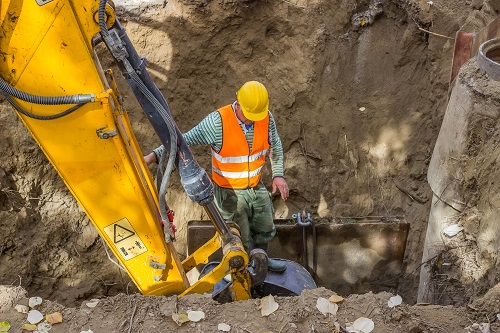Trenching and excavation work presents serious hazards to all employees involved. This June during Trench Safety Month, the National Utility Contractors Association (NUCA) and the Occupational Safety and Health Administration (OSHA) are calling on employers involved in trench work to focus on trench and excavation hazards and reinforce the importance of using trench protective systems. These tips can help employers keep trenching and excavation workers safe:

1 Promote the use of protective systems to prevent cave-ins.
Workers rarely survive a trench collapse. A cubic yard of soil can weigh as much as 3,000 pounds. Protective systems to prevent trench and excavation cave-ins include sloping, shoring, shielding, and benching. OSHA’s standard on trenching and excavation (1926.650, Subpart P) requires protective systems for trenches that are 5 feet or deeper unless the excavation occurs in stable rock.
- Sloping refers to the act of angling the side walls of a trench or excavation to prevent soil collapse.
- Shoring uses posts, planks, and hydraulic jacks to form a slope inside a trench or excavation for support.
- Shielding requires metal plates or other materials to support weak walls to stop movement if the earth starts to shift.
- Benching involves cutting a series of steps or leveled horizontal surfaces into the trench wall to create a stable working platform within the cutting area.
2 Know where underground utilities are located before digging.
Locating utility lines before excavation can prevent worker injury, fires, explosions, and serious disruption to utility services. For help locating utility lines, call the Texas Railroad Commission at 811 or 800-545-6005.
3 Ensure a safe entry and exit.
Keep ladders, steps, or ramps within 25 feet of all workers in trenches to allow for a safe entry and exit. Regularly test for hazardous vapors, gases, and lack of oxygen before and during trench work or excavation.
4 Keep materials away from the edge of the trench.
Keep all tools and any excavated materials or equipment that put extra pressure on the earth at least 2 feet from the trench edges. Never work under a raised load.
5 Use a competent person to inspect trenches and excavations.
A competent person, as defined by OSHA, must inspect trenches at the start of each shift, and after a rainstorm, or any event that could cause a possible cave-in.
For more information, download or stream any of DWC’s excavation and trenching safety publications or videos; or contact a DWC safety training specialist at SafetyTraining@tdi.texas.gov or 800-242-7031, option 2.
